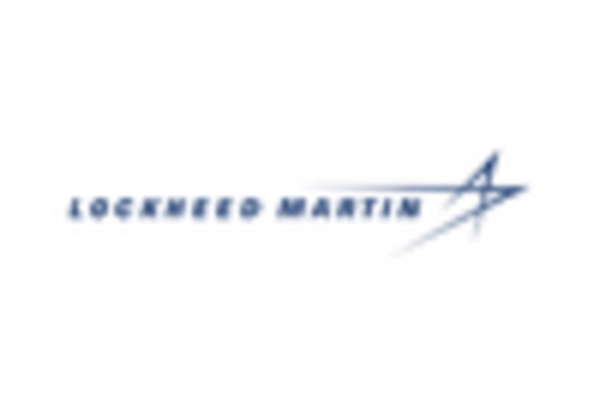The maritime patrol-aircraft market is characterized by a competitive landscape that is increasingly shaped by technological advancements and strategic partnerships. Key players such as Lockheed Martin (US), Boeing (US), and Northrop Grumman (US) are at the forefront, focusing on innovation and digital transformation to enhance their operational capabilities. Lockheed Martin (US) emphasizes the integration of advanced sensors and AI technologies into its aircraft, while Boeing (US) is pursuing partnerships with tech firms to bolster its data analytics capabilities. Northrop Grumman (US) is also investing heavily in unmanned systems, indicating a shift towards more autonomous operations. Collectively, these strategies are fostering a dynamic environment where technological prowess is becoming a critical differentiator.
In terms of business tactics, companies are increasingly localizing manufacturing and optimizing supply chains to enhance efficiency and responsiveness. The market appears moderately fragmented, with several players vying for dominance. However, the collective influence of major companies is significant, as they leverage their resources to establish a competitive edge. This competitive structure suggests that while there is room for smaller entrants, the established players are likely to maintain a stronghold through innovation and strategic collaborations.
In October 2025, Lockheed Martin (US) announced a partnership with a leading AI firm to develop next-generation surveillance systems for maritime patrol aircraft. This collaboration is expected to enhance the capabilities of their P-8 Poseidon aircraft, allowing for improved threat detection and response times. The strategic importance of this move lies in Lockheed Martin's commitment to staying ahead in a rapidly evolving technological landscape, ensuring that their offerings remain relevant and effective in addressing modern maritime security challenges.
In September 2025, Boeing (US) secured a contract with the US Navy to deliver additional P-8A Poseidon aircraft, reinforcing its position in the maritime patrol segment. This contract not only signifies Boeing's strong relationship with the US military but also highlights the growing demand for advanced maritime surveillance capabilities. The strategic implications of this contract are profound, as it solidifies Boeing's market presence and underscores the importance of government contracts in sustaining growth within the sector.
In August 2025, Northrop Grumman (US) unveiled its latest unmanned maritime surveillance system, which is designed to operate alongside traditional manned aircraft. This development reflects a broader trend towards integrating unmanned systems into maritime operations, potentially transforming how surveillance missions are conducted. The strategic significance of this innovation lies in its potential to reduce operational costs while enhancing mission effectiveness, thereby appealing to a wide range of military and commercial customers.
As of November 2025, current trends in the maritime patrol-aircraft market are increasingly defined by digitalization, sustainability, and the integration of AI technologies. Strategic alliances are playing a crucial role in shaping the competitive landscape, as companies seek to pool resources and expertise to drive innovation. Looking ahead, it appears that competitive differentiation will evolve from traditional price-based competition to a focus on technological innovation, reliability in supply chains, and the ability to adapt to changing market demands. This shift suggests that companies that prioritize R&D and strategic partnerships will likely emerge as leaders in the maritime patrol-aircraft market.

















Leave a Comment